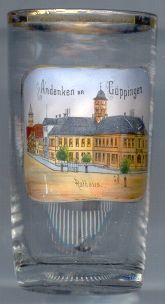

|
| DEUTSCHLAND | GERMANY |
| Bundesland: Baden-Württemberg | |
| Regierungsbezirk: Stuttgart | |
| Landkreis: Göppingen |
Göppingen is situated at an elevation of 384 m in the valley of the river Fils in the foothills of the Schwäbische Alb region, about 36 km southeast of Stuttgart.
 A document of the 16th century mentions that Göppingen was donated in 1110 to the monastery of Blaubeuren.
The oldest original document containing a reference to Göppingen dates from 1154 and was issued by King (1155 Emperor) Emperor Friedrich I
(Barbarossa) of the Hohenstaufen dynasty. During the 12th century Göppingen developed into a town, patronized persumably by the
lords of Staufeneck, bailiffs in Adelberg and at Hohenstaufen castle. After the downfall of the Hohenstaufen, Göppingen in
1273/1274 came in possession of Württemberg under Count Ulrich II. Göppingen soon became a local administrative centre.
In 1396 it even became the location of a Württemberg mint. The sulphurous waters of Göppingen were known as early as
1404. During the Thirty Years' War (1618–1648) Göppingen suffered heavily. In the year 1634/1635 alone almost 1,600
of its inhabitants were killed. The tradition of celebrating the 'Maientag' began in 1650 as a memory to the end of those hard times.
A large fire on 25 August 1782 destroyed almost the whole town. After that, the town was reconstructed on a regular,
rectangular ground plan designed by Johann Adam Groß (the Younger).
A document of the 16th century mentions that Göppingen was donated in 1110 to the monastery of Blaubeuren.
The oldest original document containing a reference to Göppingen dates from 1154 and was issued by King (1155 Emperor) Emperor Friedrich I
(Barbarossa) of the Hohenstaufen dynasty. During the 12th century Göppingen developed into a town, patronized persumably by the
lords of Staufeneck, bailiffs in Adelberg and at Hohenstaufen castle. After the downfall of the Hohenstaufen, Göppingen in
1273/1274 came in possession of Württemberg under Count Ulrich II. Göppingen soon became a local administrative centre.
In 1396 it even became the location of a Württemberg mint. The sulphurous waters of Göppingen were known as early as
1404. During the Thirty Years' War (1618–1648) Göppingen suffered heavily. In the year 1634/1635 alone almost 1,600
of its inhabitants were killed. The tradition of celebrating the 'Maientag' began in 1650 as a memory to the end of those hard times.
A large fire on 25 August 1782 destroyed almost the whole town. After that, the town was reconstructed on a regular,
rectangular ground plan designed by Johann Adam Groß (the Younger).
In the early 19th century, Göppingen obtained the status of an 'Oberamt', a regional administrative centre. In 1938 it became the administrative seat of the district Göppingen. In the 20th century the following neighbouring communities were incorporaetd into the municipality of Göppingen: Holzheim (1939), Bartenbach (1956), Bezgenriet (1957), Hohenstaufen (1971), Maitis (1972), Lenglingen (1973) and Faurndau (1975). Göppingen today has a population of about 58,000 (2004).
The  town hall [left] was constructed in Classicist style in 1785/1786.
It was the last building that was completed to reconstruct the town after the large fire of 1782.
town hall [left] was constructed in Classicist style in 1785/1786.
It was the last building that was completed to reconstruct the town after the large fire of 1782.
![[scale]](lineal.jpg)